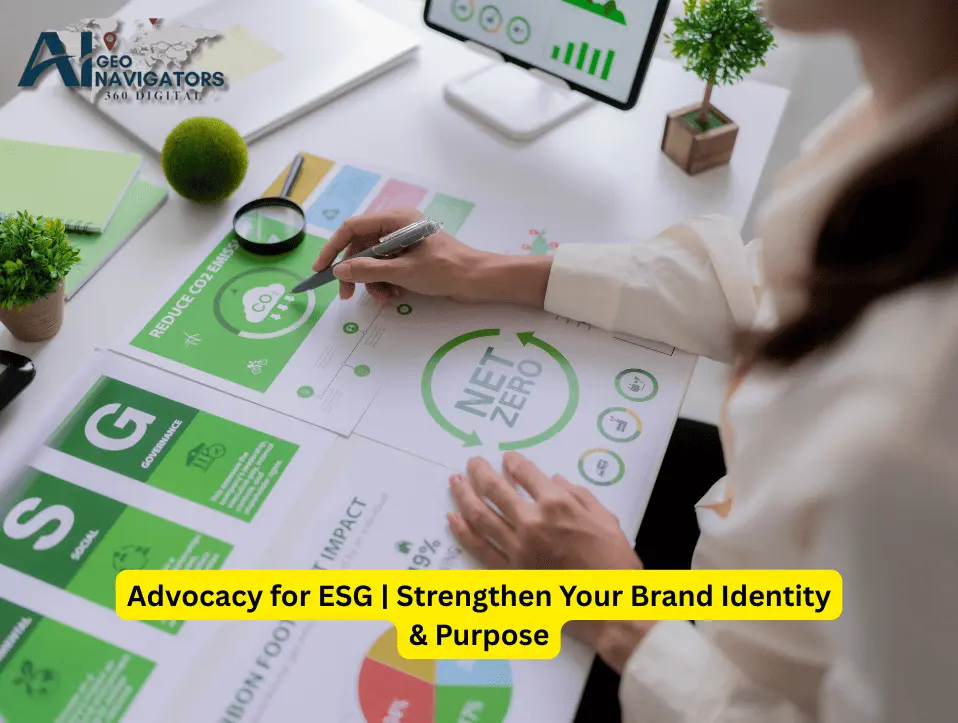In today’s business environment, simply saying you care about Environmental, Social and Governance (ESG) matters is no longer enough. Stakeholders, including customers, investors, employees, regulators and communities, expect companies to act, to communicate transparently, and to advocate for meaningful change. For companies aiming to build a strong, credible ESG brand identity, advocacy is a critical tool.
Advocacy means more than publishing reports or doing one-off initiatives. It involves a company actively using its voice and influence to champion ESG issues, align with values, engage stakeholders, and shape public perception. When done effectively, it strengthens trust, builds differentiation, and embeds ESG into the corporate brand identity.
At AI Geo Navigators, we help organizations translate ESG data, geospatial insights and storytelling into advocacy-driven brand value. In this blog, we’ll walk through why advocacy matters for ESG brand identity, how companies can build an advocacy strategy, and practical steps to implement it.
Why Advocacy Matters in ESG & Brand Identity
Trust and Reputation
Research shows that strong ESG performance enhances corporate reputation and stakeholder trust. Companies that report transparently and demonstrate genuine ESG commitment earn more loyalty from consumers, attract better talent and secure investor interest.
By advocating for ESG issues, e.g., supporting community resilience, sustainable supply chains, or inclusive governance companies communicate that they stand for something more than profit. This elevates their brand identity from “just a business” to a “purpose-led enterprise.”
Differentiation in a crowded Market
Many companies now claim to be “sustainable” or “ESG-forward”. But few go beyond internal metrics and truly advocate for change. Advocacy helps companies stand out: by using their capabilities, voice and influence to drive positive impact, they build a brand identity that is credible, memorable and differentiated. As one source puts it: “ESG is not a peripheral strategy but a central pillar for brand differentiation and consumer engagement.”
Stakeholder alignment and engagement
Advocacy helps engage a wider set of stakeholders. Employees feel motivated when they see the company acting on values. Customers feel aligned when they see real change. Investors and regulators see long-term risk mitigation. Advocacy becomes a mechanism to align the brand with stakeholder expectations—and that alignment strengthens brand identity.
From communication to action
Many companies publish sustainability reports, commit to targets and issue policies. But advocacy helps bridge the gap between communication and action. It conveys that a brand doesn’t just talk about ESG—it acts and helps others act too. This action-oriented posture nurtures authenticity, which is vital in brand identity (especially given the risk of “greenwashing” claims).
Defining ESG Brand Identity & Advocacy
What is ESG brand identity?
ESG brand identity refers to how a company’s ESG commitments and actions are reflected in its brand—through values, messaging, visual identity, stakeholder experiences, and behaviour. It means the brand is not just about products or services, it also stands for how the company governs itself, treats people, and manages its environmental impact.
Elements of ESG brand identity include:
- A clear values-based narrative (e.g., “We protect communities and the planet”).
- Consistent messaging across channels (website, reports, social media).
- Visual cues, design, tone that align with sustainability, ethics, inclusivity.
- Authentic evidence of action, not just promises.
- Engagement of employees, partners and stakeholders as ambassadors.
What is corporate advocacy in the ESG context?
Corporate advocacy goes beyond internal initiatives. It means a company publicly supports, influences or collaborates with others on ESG issues—such as pushing for policy change, working with NGOs, engaging communities, or mobilizing stakeholders.
In other words, advocacy is:
- Using the company’s voice and platform to influence ESG discourse.
- Partnering with external stakeholders to drive impact (not just internal operations).
- Creating campaigns or initiatives that reflect brand values and support change.
- Communicating the brand’s position and actions in a way that engages audiences and builds identity.
The link between advocacy and brand identity
When a company advocates for ESG issues aligned with its values, it builds identity in three ways:
- Authenticity: Stakeholders see consistency between what the brand says and does.
- Visibility: Advocacy efforts bring the brand into public view beyond product marketing—toward thought leadership, societal leadership.
- Community & mobilization: Advocacy turns stakeholders into brand allies (employees, customers, partners) who feel part of something bigger.
Thus, advocacy is a powerful lever to embed ESG into the brand.
Building an Advocacy Strategy for ESG Brand Identity
Here is a step-by-step framework companies can use to build their advocacy strategy and link it to brand identity.
Step 1: Define your ESG advocacy focus
- Use your existing ESG strategy to identify key areas where you have credibility, assets or differentiation (e.g., renewable energy, inclusive workforce, circular supply chain).
- Ask: Which issue aligns deeply with our brand values and where we can lead, not just follow?
- Example: if your company runs geospatial analytics for climate risk, your focus might be “enhancing climate resilience in underserved communities”.
Step 2: Map your stakeholders & audiences
- Identify internal and external stakeholders: employees, customers, investors, communities, regulators, industry peers, media.
- Map what each stakeholder cares about in ESG.
- For example: investors may care about governance and risk; employees about workplace inclusion; communities about environmental impact.
Step 3: Develop your storytelling & messaging
- Craft a narrative that connects your brand’s mission + ESG focus + advocacy objective.
- Ensure visual identity and tone support that message (e.g., imagery of communities, sustainability, data in action).
- Use language that is simple, credible and action-oriented.
- Avoid buzzwords unless backed by action (to mitigate risk of greenwashing).
Step 4: Choose your channels and tools
- Digital: website, blog, social media, webinars, reports.
- Media & PR: press releases, thought leadership articles, partnerships.
- Community engagement: events, workshops, stakeholder coalitions.
- Data & visuals: use GIS mapping, dashboards, infographics to show impact—especially relevant for a company like AI Geo Navigators.
Step 5: Align employees as brand advocates
- Train and engage employees so they can speak authentically about the company’s ESG advocacy.
- Encourage employee-generated content (LinkedIn posts, testimonials).
- Celebrate employee involvement in ESG initiatives so the brand identity becomes “everyone’s” responsibility.
Step 6: Measure, report and iterate
- Define KPIs for advocacy: media mentions, stakeholder engagement, campaign reach, policy influence, brand perception.
- Link these KPIs back to brand identity metrics (brand trust scores, employee engagement, customer sentiment).
- Use real data and stories. Transparency matters.
- Iterate your strategy based on results and stakeholder feedback.
Practical Tactics for Advocacy-Driven ESG Branding
Here are specific tactics companies can deploy to strengthen their ESG brand identity through advocacy.
Thought leadership & content publishing
- Publish blog posts, white-papers or articles on key ESG topics aligned with your advocacy focus.
- Example: “How small cities can use geospatial analytics to adapt to climate risk”—fits AI Geo Navigators’ expertise.
- Use accessible language, case studies, visual data and storytelling.
- Share content across social platforms and engage with your audience by asking questions or hosting webinars.
Strategic partnerships & coalitions
- Partner with NGOs, local governments, universities or industry groups on ESG initiatives.
- Example: collaborating with a city council to map vulnerable neighborhoods and publish the findings.
- When you publicly announce such partnerships, you demonstrate your brand’s commitment and advocacy role.
Campaigns & community engagement
- Launch campaigns around relevant ESG themes (e.g., “Data for Resilience”, “Sustainable Cities Hackathon”, “Youth Climate Ambassadors”).
- Include call-to-action: invite employees, customers or community to participate.
- Amplify the campaign through media, social, events, and highlight your brand’s leadership.
Transparency & reporting
- Release periodic reports or dashboards on your advocacy outcomes, not just internal operations.
- Use visuals and geospatial insights to make the impact tangible.
- Example: use maps to show where your geospatial tools helped a project reduce risk or improve sustainability. This merges AI Geo Navigators’ domain with advocacy communication.
Employee and influencer advocacy
- Equip employees with messaging, assets and opportunities to share about your ESG advocacy work.
- Recognize employee initiatives, publish their voices, and create opt-in advocacy programs.
- Collaborate with sustainability influencers or micro-influencers whose followers align with your advocacy topics.
Align brand identity visuals & language
- Ensure your brand visuals (logo, colors, typography) resonate with your ESG values (e.g., green palettes, human-centered imagery, maps, data visuals). (Greenly)
- Maintain consistent language: terms like “resilience”, “impact”, “community”, “data-driven sustainability”.
- Embed your advocacy narrative into your brand tagline or mission statement.
Use data & tech as part of advocacy story
- Companies that incorporate real data, tech insights and measurable impact build credibility. For example – GIS, remote sensing, analytics.
- For AI Geo Navigators: you can highlight how geospatial analytics supports climate adaptation, ESG risk mitigation and sustainable decision-making. This becomes part of your brand identity and advocacy story.
Contact AI Geo Navigators For Expert ESG Advocacy
At AI Geo Navigators we specialise in combining GIS, analytics and communications to help organisations build their ESG brand identity through advocacy. Here’s how we partner with you:
- Data-driven insights: We use geospatial intelligence to identify hotspots of risk or opportunity (e.g., flood-risk zones, vulnerable communities, supply chain impact areas).
- Storytelling & Visualisation: We turn raw data into intuitive maps, dashboards and narratives that stakeholders understand and share.
- Advocacy Campaigns: We help design, launch and manage ESG advocacy programmes, whether they’re community engagements, policy dialogues or brand-centric campaigns.
- Communication support: We assist with strategic PR, stakeholder engagement, digital content, blog and news section creation that amplifies your brand’s advocacy.
- Brand Identity Alignment: We ensure your visual identity, messaging, and advocacy actions align to build a consistent ESG brand story that resonates.
If you’re ready to move beyond “we do ESG” to “we lead in ESG advocacy”, we’d love to help you craft your next campaign and build your brand identity for the future.
Common Pitfalls & How to Avoid Them
Pitfall 1: Advocacy without alignment
If your advocacy focus does not truly align with your brand’s core capabilities, it can appear forced or opportunistic. To avoid this: make sure your advocacy stems from what you genuinely do well and what your stakeholders care about.
Pitfall 2: Promising and not delivering
Brands that talk big but fail to follow through risk losing trust. Regularly track, report and show results. Transparency is key.
Pitfall 3: Over-reliance on messaging, under-focus on action
Good advocacy requires more than communication, it needs program design, partnerships, monitoring and credibility. The brand identity is built through action.
Pitfall 4: Greenwashing or vague claims
Brands must be careful to avoid vague statements like “we are green” without data, evidence or measurable outcomes. Advocacy that is evidence-based and transparent is far more credible.
Pitfall 5: Ignoring internal audiences
If employees are not aligned or engaged, advocacy will feel externally driven and inauthentic. Employee advocacy is a powerful foundation.
Conclusion
In an era where ESG performance matters not just to regulators and investors but to employees, customers and society at large, advocacy is a powerful tool for companies to strengthen their brand identity. When companies move from internal ESG efforts to outward-facing advocacy using their voice, influence and capabilities, they build authenticity, engagement and differentiation.
By combining well-articulated values, stakeholder-led advocacy, data-driven action and consistent brand communication, businesses can create a brand identity that stands for something meaningful and lasting.
At AI Geo Navigators, we partner with organizations to turn ESG commitments into advocacy, and advocacy into brand identity. If you’re ready to elevate your ESG brand, we’re here to support your journey, through mapping, storytelling, campaign design and communication support.


No responses yet